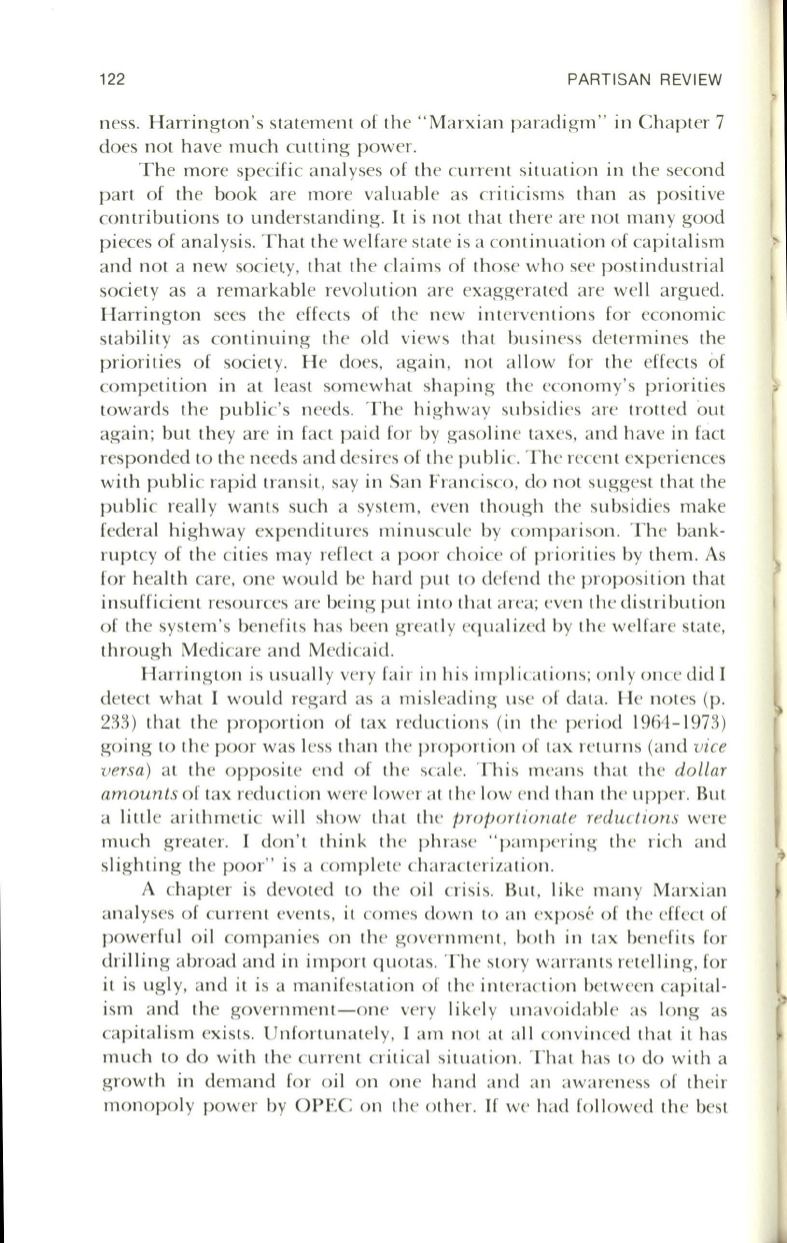
122
PARTI SAN REVIEW
ness. Harring ton 's sta tement of th e " Marxian pa rad igm" in Chapter 7
does no t have much cutting power.
T he mo re specifi c ana lyses o f the current situa ti o n in the second
pa rt of the book are mo re va luabl e as criti cisms than as pos iti ve
contributi ons
to
understanding. It is no t tha t there are no t man y good
pi eces of ana lys is. T ha t th e welfa re sta te is a continua ti on of capita li sm
and no t a new socielY, tha t the cla ims o f those who see postindustri al
society as a rema rka bl e revoluti o n are exaggera ted a re well argued.
H arring ton sees the effects of th e new interventi ons fo r economi c
stability as continuing the o ld views th a t bu sin ess determin es the
pri oriti es of society. H e does, aga in , no t a ll ow fo r the effects of
competiti on in a t leas t somewha t shap in g the economy's pri orities
towards the public's needs. The hi ghway subsidi es are trotted out
aga in ; but they are in fact pa id fo r by gaso lin e taxes, and have in fact
res ponded to th e needs and des ires of th e publi c. T he recent experi ences
with publi c rapid transit, say in San Francisco, do no t sugges t tha t the
publi c reall y wants such a sys tem , even though the subsidi es make
federa l hi ghway expenditures minuscul e by compari son . T he bank–
ruptcy of the cities may refl ect a poor cho ice o f pri o riti es by them. As
for hea lth care, one would be ha rd put to defend the propos iti on that
insufficient resources a re bein g put into tha t a rea; even the di stributi on
of the sys tem 's benefit s has been grea tl y equa li zed by the welfa re sta te,
through Medi ca re and Medi ca id .
H arrin g ton is usua ll y very fa ir in hi s im p li cations; onl y once did I
detect wha t I would regard as a mi sleadin g use of da ta. He no tes (p.
233)
tha t the p ropo rti on of tax reducti ons (in the peri od
1964-1973)
go ing to th e poor was less than the propo rti o n of tax return s (and
vice
versa)
a t the o ppos ite end o f th e sca le. T hi s means tha t the
dollar
amounts
o f tax redu cti on were lower a t th e low end than the upper. But
a littl e arithmeti c will show th a t the
proport ionate reductions
were
much g reater. I don ' t think the p hrase " pampering th e ri ch and
sli ghting the poor" is a comp lete cha racter iza ti on .
A chapter is devo ted to th e o il cri sis. But, like man y Marxi an
analyses of current events, it comes down to an expose of the effect of
powerful o il compani es on the government, bo th in tax benefits for
drilling abroad and in impo rt quo tas. The sto ry warrants retelling, for
it is ugly, and it is a manifes ta ti on of the interacti on between capita l–
ism and the government-o ne very likely unavoidabl e as long as
capita lism exi sts. Unfo rtuna tely, I am no t a t a ll convinced tha t it has
much to do with the current criti cal situa ti o n . T ha t has to do with a
growth in demand fo r o il o n o ne hand and an awareness o f their
monopo ly power by OPEC o n the o ther.
If
we had fo ll owed th e bes t


